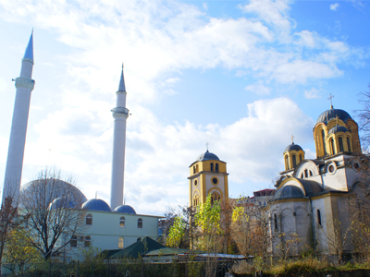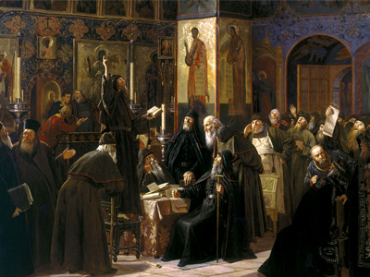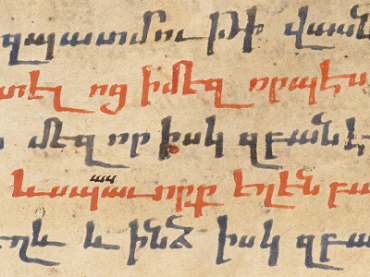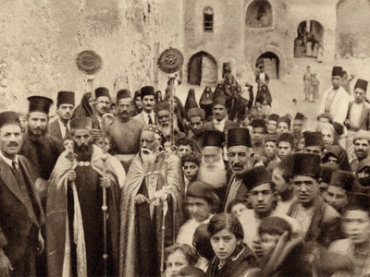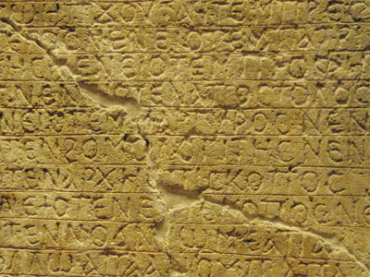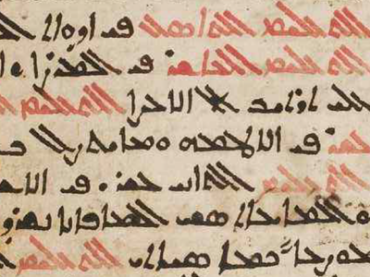Syriac and Eastern Christianity
The Sacramentary of Sarapion of Thmuis
Translated and Annotated by R. J. S. Barrett-Lennard
Series: Kiraz Liturgical Studies 26
ISBN: 978-1-60724-377-9
A text for Students, with an introduction, translation and commentary.
$138.00
Liturgy in Early Christian Egypt
Series: Kiraz Liturgical Studies 33
ISBN: 978-1-60724-384-7
Christian initiation, eucharistic liturgy and anaphora, orders, hours, and the liturgical year of the early Christian church in Egypt are the subject of this booklet.
$110.00
The Liturgy of St James as presently used
Edited with an Introduction by Phillip Tovey
Series: Kiraz Liturgical Studies 40
ISBN: 978-1-60724-391-5
The Liturgy of St James is used by a number of churches. This gives the Greek, Syriac and Reformed (Mar Thoma Syrian Church) texts in parallel columns for comparison.
$138.00
Mar Nestorius and Mar Theodore The Interpreter
The Forgotten Eucharistic Prayers of East Syria
Translated and Annotated by Bryan Spinks
Series: Kiraz Liturgical Studies 44
ISBN: 978-1-60724-395-3
This is a brilliant addition to the comprehensive range of patristic liturgical materials offered by this Series.
$138.00
The Syriac Version of the Liturgy of St James
A brief history for Students
Series: Kiraz Liturgical Studies 47
ISBN: 978-1-60724-398-4
This is a Study which will open windows galore for Westerners, for not only is the history as recorded likely to cover ground untrodden by most English-speaking liturgists, but equally the surrounding field of study and its other scholarly occupants (who are laid heavily under contribution) will also be largely unknown.
$138.00
Hippolytus: A Text for Students
Series: Kiraz Liturgical Studies 58
ISBN: 978-1-60724-350-2
This volume includes an introduction, translation, commentary, and notes.
$138.00
Fourth Century Anaphoral Construction Techniques
By John Fenwick
Series: Kiraz Liturgical Studies 61
ISBN: 978-1-60724-353-3
The origins, methodologies, and uses of the Anaphoras of Sts. Basil and James are explored, along with examples.
$138.00
A Greek and Syriac Index to Sergius of Reshaina’s Version of the De Mundo
Series: Gorgias Handbooks 12
ISBN: 978-1-60724-583-4
Sergius of Reshaina (d. 536), translated the (pseudo-)Aristotelian text known as the De Mundo from Greek into Syriac in the early sixth century. The earlier period of Greek-Syriac translation was characterized by freer versions, while in the seventh century there are very good examples of literalism. Since Sergius worked at a time between these two periods, his translation will be of special interest to Greek and Syriac scholars.
$177.00
Egyptian Origin of the Ionic Capital and of the Anthemion
Series: Analecta Gorgiana 203
ISBN: 978-1-60724-432-5
An article tracing the development of the Ionic column from Egyptian lotus motifs through Assyrian rosettes and Cypriot pottery motifs.
$40.00
Roman Church Mosaics of the First Nine Centuries with Especial Regard to Their Position in the Churc
Series: Analecta Gorgiana 283
ISBN: 978-1-60724-512-4
In this paper noted librarian, scholar, and philanthropist William Warner Bishop examines and classifies the existing church mosaics of Rome and the immediate vicinity.
$38.00
The Martyrdom and History of Blessed Simeon bar Sabba'e
By Kyle Smith
ISBN: 978-1-4632-0245-3
The Martyrdom, and the later History, of Simeon bar Sabba’e narrate the death of the bishop of Seleucia-Ctesiphon who was killed around the year 340 C.E. at the beginning of King Shapur II’s “Great Persecution” of Christians in Sasanian Persia.
$70.00
Syriac Churches Encountering Islam
Past Experiences and Future Perspectives
Edited by Dietmar W. Winkler
ISBN: 978-1-61143-001-1
The present volume includes the papers of the first PRO ORIENTE Colloquium Syriacum, which took place in Salzburg, Austria and concentrated on the Syriac Churches’ experiences with Islam. The papers in this volume survey the whole history of these two communities from the times of the Four Caliphs through the Umayyad, Abbasid, and Ottoman periods. Topics include the personal status of Christians under Islam, the ecclesiastical response to the rise of Islam, the Indian experience and the present situation.
$149.00
Hugoye - Journal of Syriac Studies (volume 12)
2009 [2011]
Edited by George Anton Kiraz
Series: Hugoye: Journal of Syriac Studies 12
ISBN: 978-1-60724-426-4
Widely regarded as a premier journal dedicated to the study of Syriac, Hugoye: Journal of Syriac Studies was established in 1998 as a venue devoted exclusively to the discipline. An organ of Beth Mardutho, the Syriac Institute, the journal appears semi-annually and will be printed in annual editions. A peer-reviewed journal, Hugoye is a respected academic source for up-to-date information about the state of Syriac studies and for discovering what is going on in the field. Contributors include some of the most respected names in the world of Syriac today. This is Volume 12 of the journal from 2009.
$75.00
An East Syrian Manuscript of the Syriac 'Masora' Dated to 899 CE (Volume 1)
A Facsimile Reproduction of British Library, Add. MS 12138
Prepared by Jonathan Loopstra
ISBN: 978-1-61143-896-3
This unique manuscript of the East Syrian Syriac ‘Masora’ is essential for any study of early Syriac vocalization, accentuation, and punctuation. This volume presents a facsimile reproduction of this ‘masoretic’ manuscript. An introduction and comprehensive scriptural indices will be included in a forthcoming volume.
$263.00
Collection of Historical Documents in Relation with the Syriac Orthodox Community in the Late Period
The Register of Mardin MS 1006
Series: Gorgias Eastern Christian Studies 24
ISBN: 978-1-60724-994-8
In the Ottoman Empire, Syriac communities kept their own baptismal books, marriage, funeral and other records and many of these can be found in various libraries, churches, monasteries in the West and East. The Syriac Garšūnī manuscript found in the Church of the Forty Martyrs in Mardin contains several lists of different subjects that go back to the late period of the Ottoman Empire. These lists, published here for the first time with annotations, are an important historical source for the social, economic, cultural and religious history of the Near East during the 19th century.
$153.00
An Outline of Middle Voice in Syriac
Evidences of a Linguistic Category
Series: Perspectives on Syriac Linguistics 6
ISBN: 978-1-4632-0145-6
This study presents a modern linguistic approach to the function of the Syriac et-verbal prefix. Based on a detailed analysis of a number of early Syriac texts, it proposes a unified account of the different values traditionally attributed to the Syriac et- stems. Farina views the data within a typologically comparative framework derived from a cross-linguistic study of middle conjugations.
$132.00
The Nomocanon of Abdisho of Nisibis
A Facsimile Edition of MS 64 from the Collection of the Church of the East in Trissur
Series: Syriac Manuscripts from Malabar 1
ISBN: 978-1-59333-968-5
This book is one of the most important sources for the canon law of the East-Syrian Church. In Canon I of the council held in the year 1318, this collection was proclaimed the authoritative canon law and has since retained its status as the binding legal collection of the East Syrian Church. This second edition reproduces the original manuscript in color.
$366.00
The Ottoman Süryânî from 1908 to 1914
ISBN: 978-1-60724-069-3
This work explores the misconceptions about the Ottoman Süryânî community of the pre-World War I era, using a critique of the present day historiography as the context for the discussion. The works of three early twentieth century journalists, provide the material for the study. The author contends that this group cannot be considered as Assyrian nationalists, the traditional argument, that they saw the future of the Süryânî people as best secured by the continuation of the Ottoman Empire, in which they sought a greater presence for their community.
$180.00
The Influence of Origen on the Young Augustine
A Chapter of the History of Origenism
By György Heidl
Series: Gorgias Eastern Christian Studies 19
ISBN: 978-1-59333-702-5
The main purpose of the book is to demonstrate that as early as the first phase of his activity (386-393 AD), Augustine did make use of some Origenian works, and that basic elements of his early theology were derived from the Alexandrian master.
$219.00
Possible Historical Traces in the Doctrina Addai
Series: Analecta Gorgiana 399
ISBN: 978-1-60724-662-6
The Teaching of Addai is a Syriac document convincingly dated by some scholars in the fourth or fifth century AD. I agree with this dating, but I think that there may be some points containing possible historical traces that go back even to the first century AD, such as the letters exchanged by king Abgar and Tiberius. Some elements in them point to the real historical context of the reign of Abgar ‘the Black’ in the first century. The author of the Doctrina might have known the tradition of some historical letters written by Abgar and Tiberius.
$50.00
Symbola Caelestis
Le symbolisme liturgique et paraliturgique dans le monde chrétien
Edited by Andrei A. Orlov & Basil Lourié
ISBN: 978-1-60724-665-7
The volume deals with the liturgical dimension of mystical, ascetical, and hymnographic texts and traditions within the Christian environment. Special attention is paid to liturgical texts of the Coptic and the Byzantine rite, especially in its Slavonic and Georgian versions. The volume also explores the Jewish background of some Christian liturgical settings and the afterlife of the Jewish priestly and liturgical traditions in the Christian milieu. The collection includes the critical edition of the early Slavonic version of the liturgy of the Presanctified Gifts accompanied by the historical study of this service.
$211.00
Hugoye - Journal of Syriac Studies (volume 11)
2008 [2011]
Edited by George Anton Kiraz
Series: Hugoye: Journal of Syriac Studies 11
ISBN: 978-1-60724-672-5
Widely regarded as a premier journal dedicated to the study of Syriac, volume 11 includes the following articles: "Syriac manuscripts in the New York Public Library" by Iskander Sharbil Bcheiry, "Early Christian Angelomorphic Pneumatology: Aphrahat the Persian Sage" by Bogdan Bucur, and "John of Damascus and the Church in Syria in the Umayyad Era: The Intellectual and Cultural Milieu of Orthodox Christians in the World of Islam" by Sidney H. Griffith.
$75.00
The Assyrians in Australian Archives
Documents from the National Archives of Australia and Australian War Memorial, 1914–1947
Edited by Stavros T. Stavridis & David Chibo
Series: Gorgias Handbooks 17
ISBN: 978-1-60724-993-1
The small Assyrian community proved to be loyal, dedicated and hard-working citizens of Australia during the years 1914–1947. For the first time the Assyrian issue will be seen through the eyes of Australian official documents and it is hoped that this monograph will raise awareness of these people within Australia and abroad.
$210.00
Eine aegyptische Mess- und Taufliturgie verrmutlich des 6 Jahrhunderts
Edited with an Introduction by Anton Baumstark
Series: Analecta Gorgiana 400
ISBN: 978-1-60724-674-9
Anton Baumstark presents the Arabic text and Latin translation of an Egyptian version of the Testamentum Domini Nostri Jesu Christi. Baumstark discusses the date of the text and compares the content of the liturgical prayers with various contemporary sources.
$40.00
Un recueil de sentences attribué à Isaac le Syrien
Edited with an Introduction by Marius Besson
Series: Analecta Gorgiana 401
ISBN: 978-1-60724-675-6
Marius Besson presents the critical text of two manuscripts containing an apophthegmatic text with sayings attributed to Isaac of Nineveh. The text also includes a separate apparatus with references to parallel texts in various early Christian documents.
$35.00
Filter by
Filter by price
Filter by manufacturer

